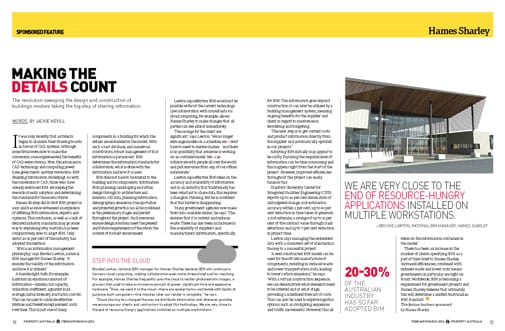
by
Property Australia
28 Feb 2014
pp. 42-43

It was only recently that Architects began to abandon their drawing boards in favour of CAD systems. Although some firms were slow to make the conversion, once implemented the benefits of CAD were obvious. Whereas early CAD systems were essentially electronic drawing boards, they soon developed into a comprehensive set of tools for streamlining the documentation process. One of the more notable developments was the ability to overlay Consultants’ CAD drawings, providing more accurate collaboration than traditionally possible.
The ongoing advances in CAD technology and computing power have given rise to another revolution: BIM (Building Information Modelling). As with the conversion to CAD, those who have already embraced BIM are reaping the rewards of early adoption, and determining the standards for those who follow. Since their first BIM project in 2005, Hames Sharley has seen the industry overwhelmed with differing BIM information, experts and opinions. This conflicting information, as well as a lack of declared industry standards, may go some way to explain why Australia has been comparatively slow to adapt to BIM. Meanwhile, Australian practice Hames Sharley has quietly remained at the forefront of BIM, investing significantly in research and technology and streamlining systems to take advantage of the available technology.
“The M in BIM is the misunderstanding” states Brooke Lawton “To Architects, a model is a 3D representation of the built form. To the IT industry however, a model is a database of information representing a process, and it is this interpretation that we are concerned with here. BIM is not a 3D model, a tangible product, or any one software application. In fact, we regard any application that is used in the course of a project as being part of our BIM process: CAD, 3D modelling, word processing, spreadsheets and even hand-drawn sketches all contribute to the information model.
“BIM is an information management philosophy. It is about ensuring the accuracy of the information and how we utilise that information”.
As a company spanning 12 portfolios, Hames Sharley has access to a wide array of information from planning, landscaping and urban design through to architecture and interiors. Comprehensive GIS data and planning information including socio-economic demographics, emissions, transportation and projected growths can all be combined in the preliminary stages of a project. Utilising resources such as these ensure that design solutions not only address the Client brief, but also meet the present and future requirements of the site in the context of its built environment.
Effective BIM relies on the availability of information, and in an industry that has traditionally been reluctant to share data, this has required a change in thinking. But Hames Sharley is confident that this barrier is disappearing. “Many Government agencies now have data available online. It ensures that it is current and reduces waste. We have also seen a recent increase in the availability of Suppliers’ information, specifically for BIM. Having current and relevant data directly from the manufacturer prevents inconsistencies, and if the manufacturer is willing to make that information readily available, it will ultimately be to their benefit. This goes beyond construction; information can later be utilised by a Building Management System (BMS), meaning ongoing benefits for the supplier and Client in regard to maintenance, reordering and budgeting.
3D animations and realistic graphics are valuable tools, but they are merely by-products of a BIM project. Hames Sharley maintains that the real power of BIM is the embedded information, and managing this with a consistent set of data standards is the key to a successful project.
“A well-constructed BIM model can be used for the off-site manufacture of components resulting in reduced waste and lower transportation costs. With a virtual construction sequence, we can demonstrate what elements need to be ordered and at what stage, providing a scheduled forecast of costs. This can also be used to explore logistics options such as stockpiling sequences and traffic movements. However, this all relies on the information contained in the model.”
Worldwide, BIM is becoming a requirement for Government projects, and Hames Sharley believes that this will ultimately determine a unified Australian BIM standard. “We have also seen an increase in the number of Clients asking about BIM, or even specifying BIM as a part of their brief. We always ensure that our Clients understand what a BIM project entails, and explain the process in detail. Clients frequently ask if they need to commit to BIM for the entire project, or just to a certain stage (for example, not every model will be required for facilities management). We can take BIM to any stage in a project, but it is important to note that the information will nonetheless be embedded in the model right from the beginning.”
With the current pace of change in the industry, the future is impossible to predict, so what does Hames Sharley see as the next big step with BIM? “Cloud computing has been around for a while now but like anything new there is a level of resistance. This is quite understandable where it involves storing data off site and relinquishing control of infrastructure. However, we’re already seeing an immense benefit with cloud-based applications such as Autodesk’s rendering service, which saves a significant amount of time and removes the need for dedicated and expensive hardware.”
Having used Revit Server for a number of years to utilise resources between offices, Hames Sharley has now developed their own cross-domain, cloud-based file-sharing system allowing for real-time collaboration with Consultants. “The result is increased communication, instant resolution of clashes and an overall improved collaborative process. The next step is to collaborate with manufacturers, where their information is updated live from an online database.
“Cloud sharing has changed the way that we distribute information, and wherever possible we encourage our Clients and Contractors to adopt this technology. We are very close to the end of seeing resource-hungry applications installed on multiple workstations”.